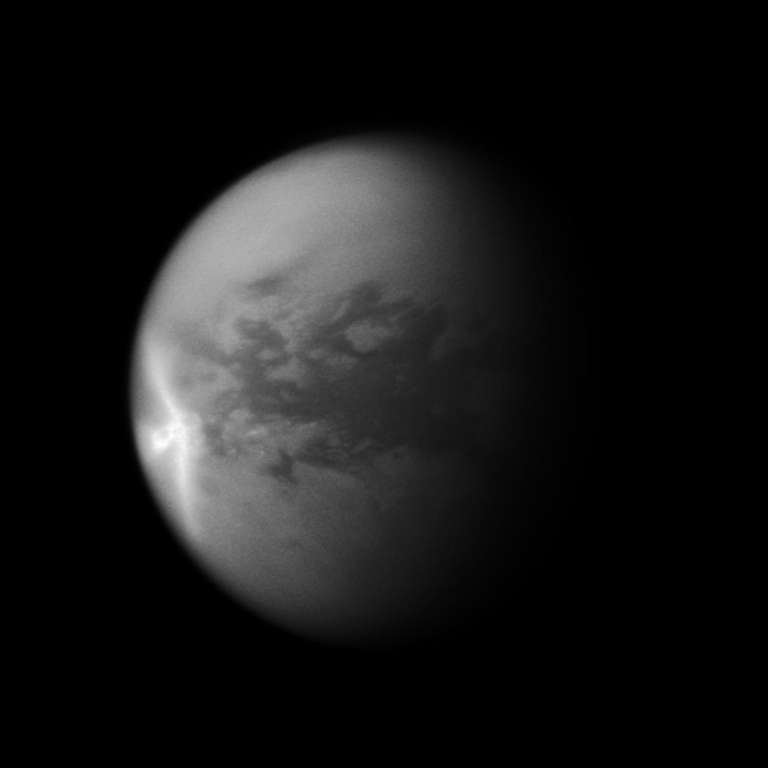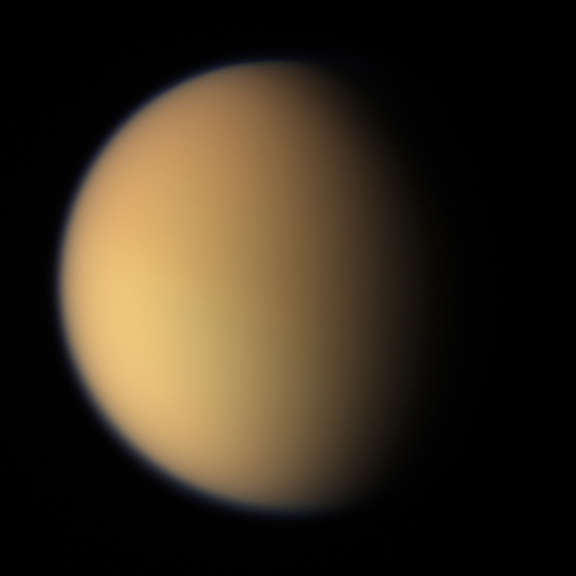All
All
Stories, updates, insights, and original analysis from The Planetary Society.
Pretty picture: Halo on a halo?
An interesting set of images of Titan that Cassini took recently shows a peculiar cap at Titan's south pole.
Titan, Dead or Alive? A Debate
A lively discussion and debate between planetary polymaths Ralph Lorenz and Jeffrey Moore about Titan, hosted by the Denver Museum of Nature and Science, moderated by David Grinspoon.
Notes from the Lunar and Planetary Science Conference: Making Cassini's radar images prettier
One of the more exciting talks last week was given by Antoine Lucas about his work with Oded Aharonson
Notes from Titan talks at the 2012 Lunar and Planetary Science Conference (LPSC)
One of the topics I found most exciting yesterday was a series of talks on Titan's climate. Bob West showed how Titan's detached haze has shifted with time. Zibi Turtle presented about how Titan's weather has changed with these seasonal changes. Jason Barnes followed up Zibi's talk -- which was based on Cassini camera images -- with a study of the same regions using data from Cassini's imaging spectrometer, trying to figure out what was going on with that brightening. Ralph Lorenz talked about rainfall rates on Titan. Jeff Moore asked: what if Titan hasn't always had a thick atmosphere?
Parallel planetary processes create semantic headaches
I ran into a semantic problem today: what to call the science of studying liquids on Titan?
Watch this week's Google+ Space Hangout
This week's lineup is a largely astronomical crowd so most of the conversation concerned dark matter and boiling exoplanets and imaging the black hole at the center of our galaxy.
Evaporites on Titan
Evaporites form on planetary surfaces when dissolved chemical solids precipitate out of saturated solution as their liquid solvent evaporates and, until recently, were known to exist only on Earth and Mars. This article from the IAG Planetary Geomorphology Working Group describes the third planetary instance of evaporite, discovered on Saturn's moon Titan.
Pretty picture: Saturn, a big moon, and a teeny one
A recent view from Cassini of Saturn with its largest moon (Titan) and one of its small ringmoons, Prometheus.
Pretty pictures & movies: Eye candy from two recent Cassini Enceladus flybys
Cassini has completed two very close flybys of Enceladus in less than three weeks, one of them just this morning, and the images from that encounter have already arrived on Earth.
Brief notes from Day 2 of the DPS-EPSC meeting
It's been a very full day at the DPS-EPSC 2011 joint meeting. My day was less full than it might have been, because I overslept and missed most of the morning's session. I really needed the rest though so I think it was probably for the best!
Pretty pictures: Dancing moons
Since Cassini currently orbits Saturn within the plane of Saturn's rings, it has lots of chances to catch two or more moons in the same photo. One such
Scale solar system presentation slide, a provisional version for you to review
I'm preparing a talk for the Pacific Astronomy and Telescope Show here in Pasadena on Sunday afternoon at 1:45. I have spent the morning putting together a slide that I have long wanted to have for presentations.
New Horizons Day 2: Liquids on Pluto's surface?
Jeff Moore's presentation was cool because of the discussion it stimulated. He considered what exogenic processes might be operating on Pluto's surface. What's an exogenic process? It's something that modifies the shape of the surface from the outside, and doesn't require the body to be geologically active inside.
Titan crater and programming note
The summer is winding to a close but it's not quite over for me -- by which I mean my children -- yet.
Cassini animations: Rhea and Dione and Titan
I've been mucking about in the Cassini data archives (as I often do when procrastinating) and unearthed a neat, if short, mutual event sequence of two crescent moons passing by each other.
Tantalizing photos of Titan, Dione, Tethys, and Saturn
It figures. I just start a three-week trip, with my only computer a diminutive Netbook, and guess what's just been radioed across the 1.3 billion kilometers separating us and Saturn? A set of photos that should become -- when properly processed -- an iconic image from Cassini's fourteen-year mission to the Saturn system.
Titan's lack of lightning
It's a fact of life in science that not all of your hypotheses will turn out to be correct (or even verifiable at all). But there's a bias toward the publication of positive results -- the discovery of this, or the proof of that.
Are there more Titans than Earths in the Milky Way?
Might there be many Titan-like planets and moons, with atmospheres and liquid methane rain, rivers, and lakes, across the galaxy? It's an important question if you think that liquid methane environments could support alien life, because it turns out that Titan-like planets might be more common than Earth-like planets.
Lots of great stuff in the latest Cassini data release
I've got some lovely pictures from Saturn to show you! Every three months, the Cassini mission dumps gigabytes worth of precious Saturn data into the Planetary Data System, and the latest gift came on April 1. This particular pile of data, which was taken between April 1 and June 30, 2010, contains a lot of really terrific moon observations.
365 Days of Astronomy Podcast: What's up in the second quarter of 2011
Regular readers of this blog will find the content of today's 365 Days of Astronomy Podcast familiar, because it's an update on what the solar system exploration spacecraft are up to, based on my monthly


 Explore Worlds
Explore Worlds Find Life
Find Life Defend Earth
Defend Earth


 Sun
Sun Mercury
Mercury Venus
Venus Earth
Earth Mars
Mars Jupiter
Jupiter Saturn
Saturn Uranus
Uranus Neptune
Neptune Small Bodies
Small Bodies
















